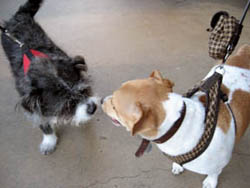

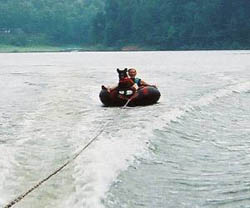
Maggie loves to go tubing on the lake!
She's wearing her life preserver because
safety should always come first!
By the way did you know that not all dogs
can swim? Don't ever assume your dog
can until you've seen them in action. Start
shallow and work your way to deeper water
Never throw your dog into deep water
unless you're prepared and able to dive
in after it and get it to shore if it sinks
instead of swims.
• • • • • • • • • • • • • • • • • •

Brodie's Toy Basket
• • • • • • • • • • • • • • • • • •
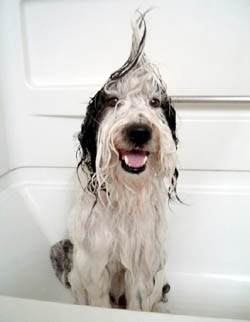
Storm shows how fun a bath can be!
Click Here
to see more cute dogs taking baths.
|
|
The following information was compiled from many sources. My own experiences, those of
personal friends and many many of my pals on Dogster.com who all care deeply about
their own pet(s)... And the welfare of all dogs everywhere.
ANYONE CAN BUY A DOG...
ARE YOU READY TO MAKE THE COMMITMENT TO PROPERLY CARE FOR A DOG?
It takes more then love or the desire to own a pet to give a dog the home it deserves.
Listed below are the crucial elements needed to provide a dog with all of the most basic requirements to be both physically and mentally well balanced. If you can't honestly say yes to all of the conditions listed below perhaps now isn't the "right" time to own a dog. If your heart is open to it and your main goal is to simply be around or help dogs other options exist such as fostering or volunteering for a rescue or shelter until the time is right.
Almost anyone can afford to buy a dog... From a $10 puppy at a flea market to a $1000 purebred dog they all share the same basic needs and requirements. It doesn't matter how much money you can afford to spend on a dog to buy it, it's the amount of time and energy you are willing to dedicate to it once you have it that matters most. |
Exercise • Out of the Yard • Socialization • Training • Baths • Housing • Toys • Cost |
EXERCISE
Size is NOT a factor in determining a dogs requirement for exercise. |

Bailey out for a hike. |
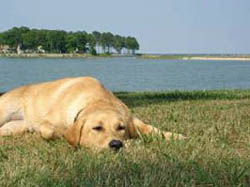 Happy and exhausted!
Happy and exhausted! |
1. The breed, body type, and age of your dog will dictate the amount of exercise it needs.
2. The average physically sound dog NEEDS a minimum of 2 walks per day that equal 1 hour of walking time, rain or shine, to stay mentally and physically fit.
Dogs need exercise to burn calories, stimulate their minds, and keep healthy.
Sufficient exercise helps dogs avoid boredom, which often leads to destructive behaviors like excessive barking, digging, and chewing.
Individual exercise needs vary based on breed or breed mix, sex, age and level of health. A walk around the block is not sufficient exercise for most dogs. If your dog is a 6 to18 month adolescent, or if is is an active breed or mixed-breed from the sporting, herding, hound or terrier groups, its need for walking will be even higher. Some of the happiest and most well behaved dogs are walked anywhere from 1 to 3 hours a day.
|
GETTING OUT OF THE HOUSE AND BACKYARD
It doesn't matter how large your yard is... All dogs need to be taken out of your home and yard to be mentally balanced. |
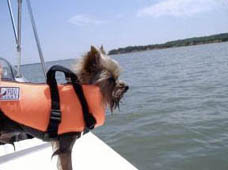 Brody spending a day on the water
Brody spending a day on the water. |
One of the most common forms of unintentional neglect when it comes to pet dogs is that many owners overlook the importance of taking their dog off of their property on a regular basis. The mental stimulation that dogs receive when you take them places is priceless.
The other benefit to taking your dog "out?" It will help to keep them dog and people social. The owner of a well socialized dog should take a lot of pride in being able to take their dog any place at anytime. It seems like a given but there are too many dogs who for a multitude of reasons are isolated within their own house or yard. This type of isolation can cause both aggression issues due to lack of socialization and neurotic behaviors due to boredom.
Is this something you will give your dog? Time away from the house to have fun being a dog? Dogs need more then just a backyard! Make the commitment to give your dog adventures away from home.
And keep them safe. Always obey leash laws, if near water use a flotation device if your dog doesn't know how to swim or is a weak swimmer, and carry a deterrent like Direct Stop in case you come across an aggressive loose dog.
Back to Top of Page
|
Places to take your dog?
• A daily walk
• To the park
•
To a dog friendly shopping district
• To a dog friendly sidewalk cafe
• To a beach or lake
• Hiking
• Dog friendly festivals and events
• Doggie social events |
|
SOCIALIZATION
A lack of socialization with both people and other dogs will lead to a potentially aggressive animal that must be kept separated from the rest of the world to ensure the safety of others. |
|
|
Kitai meets Eddie. |
Zeus and Grace |
Are you willing to make the commitment to invest the time to ensure that your dog is a friendly canine citizen?
This means taking your dog outside of your home and yard on a regular basis. This can be in the form of it's daily walks or to parks, dog friendly shopping districts or to visit friends.
If you only have one dog will you be willing to find other dogs for your pup to play with so that it learns to behave in an appropriate and friendly manner towards other dogs? Arranging doggie play dates or group walks may sound a little silly if you've never done it before but is the first step in creating a socially well balanced dog that can be trusted to interact with both people and other dogs in a non-threatening manner.
If you own more then one dog that's great! Your dog will appreciate the companionship but be aware that in some cases dominance issues may develop. Seek help immediately, do not wait until fights ensue and one dog seriously injures the other. A reliable trainer or behaviorist can help you work through such issues.
Failure to properly socialize your dog can lead to bites which lead to lawsuits... So it is in everyone's best interests, both yours and your dogs, to take the time to do this right.
PLEASE READ: Regarding all Dogs and Children
Dogs and young children must be supervised AT ALL TIMES!
Many dog bites are the result of a child intentionally or accidentally provoking a pet by chasing, poking, hitting, slapping or often trying to put an object in the ear, nose or mouth of a dog.
Without supervision, the result will often be the dog bites the child. This is never the fault of the dog but the fault of the adult or adults who should have been supervising the interaction between the child and the pet.
|
|
TRAINING METHODS... Why all dogs deserve and need proper training.
Behavior issues are one of the leading reasons dogs are surrendered to shelters and pounds. |
All dogs should receive a minimum of level one basic obedience training. The cost and effort are small compared to the benefit you will gain by owning a well behaved dog.
Puppies can be enrolled in obedience courses when they have been adequately vaccinated. Contact your local humane society or SPCA for training class recommendations.
Dog training has now advanced from the classic obedience school approach and now encompasses dog behaviorists for specialized problems. |
Popular Books:
(in alphabetical order)
Bones Would Rain from the Sky
Cesar's Way
The Other End of the Leash
|
|
Many trainers today focus on positive training techniques such as Clicker training or "Nothing in life is free" commonly known as "NILF."
Hitting or using any training method that causes you dog physical pain should not be used in any situation.
You should always keep your puppy or dog on a leash in public. Thousands of dogs are hit and injured or killed by cars each year. Their devastated owners are left with the guilt of knowing had they kept their pet leashed it would still be alive today.
Bad behavior should never be accepted. Any form of aggression could cost your dog it's life if you ever need to surrender it to a shelter or rescue as dogs with aggression issues are often put down since neither organization can afford the liability if they re-home a potential biter and the dog bites or mauls anyone. This includes food aggression, aggression over possessions such as toys, areas or rooms, aggression directed towards other dogs and of course actually biting people. Dog owners need to have a zero tolerance when it comes to aggression of any type.
|
TOYS
More then just something to play with |

Lea and Lena
|
Toys can be key in keeping a dog mentally balanced. Just like kids the mental stimulation they provide are invaluable. They can help to wear your pup out both mentally and physically, which in turn creates a more calm and easy going pet.
Some in particular are mentally stimulating and play off of your dogs natural instincts.
Keep in mind that all can be chewed apart and can create both choking and blockage hazards. This only means that you should supervise your pup especially when giving any new toy so that you can monitor how your pup plays with it and whether it is safe for him or her to play with when you are not around to supervise.
For instance if your pup chews or tears a plush toy apart and swallows any of it? A more appropriate toy might be a Nylabone. If your pup is bored with a Nylabone then a food/puzzle toy might be perfect for your pup. If you really want to keep your dog occupied teach it to play with different styles of toys and rotate them on a regular basis to keep him or her interested. Some toys will only be safe for use under your direct supervision, others will be safe to leave available at all times. |
|
BATH TIME
... Doesn't have to be traumatic or stressful |
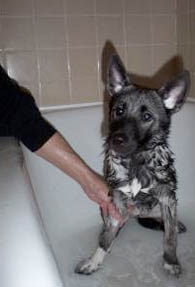 Ursa shows how it's done!
Ursa shows how it's done! |
Contrary to what many people believe dogs can and should be bathed more then once per year. Just be sure to find a gentle dog shampoo that won't irritate your pups skin. I've used several brands of SOAP FREE shampoos on Kitai and have had no problems with skin irritation or sensitivity. In the summer he's had baths as often as once every 2 weeks.
If your dog is clean and not stinky it will be much easier to keep it in the house as part of the family and will make it more likely that you'll take your pup out in public. Nobody wants to pet a stinky dog.
A great way to make bath time stress free is to start training your dog early to sit in the tub. Even if it's just a puppy, put it in the tub, wait until it's calm then give it a treat or two. Let it out of the tub and repeat the exercise frequently. Soon your pup will associate the tub with treats. When you get to the point where your pup will sit calmly in the tub you can try an actual bath. A rubber bath mat will stop paws from slipping. |
My last dog, who was a puppy when I got him, would actually hop into the tub when I told him to. Since Kitai was almost a year old when I adopted him, it was harder but he is now to the point where he will calmly let me bathe him in the tub or shower.
I use a shower wand for dog washing. The flexible hose makes rinsing a breeze!
Back to Top of Page |
|
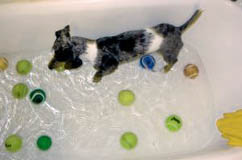 Gemini loves her BATH TIME!
Gemini loves her BATH TIME! |
|
HOUSING
If one member of your household is opposed to allowing a dog indoors... Please do not bring home a puppy with the "hope" they will change their mind... |
All too often a dogs fate is sealed before it ever had a chance at a life full of love and contentment. If your significant other is opposed to allowing a dog into the house, and you are NOT the kind of person who will spend sufficient quality time with it outdoors, please do NOT get a dog as a pet. Some working breeds, such as farm or guard dogs, can be content when kept outdoors with adequate shelter and at least 1 other dog but most companion breeds will not be happy living outdoors year round.
It's truly heartbreaking the number of dogs that are cast aside to live a decade or more in a backyard, basement or garage, often chained, year after year because their owners are unwilling to make them an integral part of their family unit.
|
 Loki has fun playing, not living, in her backyard.
Loki has fun playing, not living, in her backyard. |
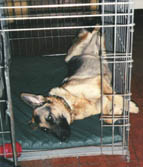 Vincent Napping in
Vincent Napping in
His Wire Crate |
CRATING INDOORS
Not every dog needs a crate but if yours does think of a crate as personal space for your pup. It's somewhere they can go to just hang out and relax or nap. How long is too long? Dogs should not be crated for more then 8 hours a day, total. If you need to crate your dog while at work be sure to tire it out by give it a long walk before crating and another in the evening to give it the exercise it needs and to keep it mentally balanced. If you can afford a dog walker to come by and take your dog out for a little stretch mid-day even better! |
| A crate is essential if you have a dog that loves to chew on things that could make it sick or injure it. For instance say you have a dog that tries to chew on lamp cords or who knows what. Rather then risk electrical shock a blockage or internal perforation if your pup swallows something it shouldn't have, a crate will keep it safe while you are out or at work.
If you need to crate your dog for more then 10 hours a day, again the question should be asked: Do you really have the time needed to give a dog a proper home? If the answer is no, look to be around dogs by volunteering with your local Humane Society or a rescue group or offer to walk a friend or neighbor's dog.
View More Dogs Who Love Their Crates: CLICK HERE |
Even when you're home a crate trained dog will use their crate for napping and playing. |
|
|
Scout in Her Plastic Crate
|
Little Charlie Taking a Nap |
If you keep your dog outdoors:
If your dog will be spending a lot of time or living outdoors, be sure it has access to shade and plenty of cool water in hot weather, and a warm, dry, covered shelter when it's cold.
1. Do NOT CHAIN YOUR DOG. If a fence is nonexistent or inadequate use an aerial trolley system instead of a chain. Chained dogs suffer from boredom, aggression, and often are strangled to death when they attempt to jump a fence or fall off of a deck and the tether isn't long enough to allow them to land on the ground.
2. Be aware. There are a shocking number of cases of dogs being fed meat poisoned with anti-freeze thrown over the fence into the dogs backyard. Neighbors who tire of hearing a dog barking all day long have been known to go to such despicable methods in order to silence a noisy dog. Keeping your dogs outdoors offers them no protection from those who might try to harm them this way.
But make no mistake. As an owner it is your responsibility to not impose upon your neighbors by allowing your dog to bark incessantly. What can you do to stop it?
Look at your pets reasons for barking. Is it bored? Territorial? In both cases you can take steps to curb the noise. Giving your dog a safe toy like a Nylabone or a Kong stuffed with frozen yogurt or peanut butter may occupy it for hours. If it barks when people come near your property you can work on desensitizing it. A qualified trainer or behaviorist may be able to show you how.
To me the sad sound of a lonely dog barking out of boredom can be as heartbreaking as it is annoying.
Believe me, I've lived next door to a noisy dog more then once. In both instances I found approaching the owners in a friendly manner when the dogs weren't barking allowed dialogues to take place that made them much more considerate to control excessive barking when they were home. But during the day while they were at work? The barking would go on and on. If you are being imposed upon by a too noisy dog please exercise your right to file a noise complaint to your local Animal Control office or Police Department. Either can tell you who the appropriate person to contact would be in your city.
Another option would be to try a remote anti-barking device. I once met a couple who swore a "Barker Breaker" cured their problem with their neighbors noisy dog. No neighbor should be forced to go out and buy such a device but if you want relief without having to confront your neighbor? This might be a solution.
Even if your dogs are kept indoors vigilant owners will walk their yard each day to insure nothing harmful has been tossed onto their property before allowing their dogs outside.
A dog left outdoors is also an easy target for dog thieves. There are people in this world who steal pets from yards to sell them to Class B dog dealers. These are the people who sell animals to experimental laboratories. HBO did a documentary in 2006 about this industry called Dealing Dogs. Warning: The movie and description are graphic.
3. Provide adequate shelter. This means a water proof dog house that if you live in cold areas is insulated and or heated for winter. There should be some type of bedding such as a blanket, pad or straw and a door that will not allow the wet or wind to come into the house.
Back to Top of Page |
|
 Boss and Marley love their dog house!
Boss and Marley love their dog house! |
|
|
The average annual cost of owning a dog, depending on the size of the dog and the cost of living in your area, can range from as little as $300 per year to as high as $1000 per year. This doesn't include medical emergencies which as dog owners know, one little accident and you can be spending thousands in single day to keep your pet healthy and alive.
For more detailed information associated with costs of keeping a dog visit Pet Education.com
|

Miss Frankie's owner spent over $5000 to save her from Parvo after purchasing her from the worst kind of Backyard Breeder. |
Monthly PARASITE control
Fleas
Daily inspections of your dog for fleas and ticks during the warm seasons are important. Use a flea comb to find and remove fleas. There are several new methods of flea and tick control. Speak to your veterinarian about these and other options.
Heartworm
This parasite lives in the heart and is passed from dog to dog by mosquitoes. Heartworm infections can be fatal. Your dog should have a blood test for heartworm every spring—this is crucial for detecting infections from the previous year. A once-a-month pill given during mosquito season will protect your dog. If you travel south with your pet during the winter, your dog should be on the preventive medicine during the trip. In some warmer regions, veterinarians recommend preventive heartworm medication throughout the year.
SPAYING & NEUTERING
PLEASE spay and neuter your pets! It will 100% guarantee that you and your pet will not become part of the problem of pet overpopulation. There are an estimated 4 million, yes I said MILLION, dogs and cats that are put to sleep each year in this country. Many perfectly healthy, the only thing wrong is that nobody wanted to give them a home. So please for the sake of those animals already in shelters waiting for homes please do NOT choose to breed your pet and create more puppies that may very well take the home of a dog that is sitting on doggie death row.
If you want to experience the miracle of birth foster a pregnant rescue dog. That way you can see and be around puppies and know you are doing something wonderful giving both the mother and her pups a shot at having a long and happy life. What could be more sad then a pregnant dog being put to sleep? Yet it happens all too often.
In male dogs not neutering can lead to unwanted behaviors like urinating and marking indoors, mounting/humping people other pets and objects, escaping your property to follow the scent of a female in heat and is a factor in some aggression issues. Statistically an un-neutered male dog is the dog most likely to bite and/or seriously maul or kill a human being.
As with any surgical procedure there are risks when spaying or neutering any at any age. Be sure to consult with your vet and if needed, request additional screening tests are done to ensure that your pet is in physical condition to withstand a normal procedure and recovery.
Different clinics may test different things for their pre-surgical blood work which can range from $30 to $120.
The most common test are for BUN, Creatinine, and ALT. The first 2 check kidney function, the last one checks liver function. If the ALT is off, your surgeon will want to run some additional test. If any are severely off, your vet should not proceed with surgery, and should send in a panel called "Total Body Function" to Antech. (A SuperChem, CBC, and T4.)
Financial Assistance Programs for Veterinary Bills
American Animal Hospital Association
Helps those in need access quality veterinary care for their sick or injured pets. We raise funds and award grants supporting veterinary care for pets that have been abandoned or whose owners are experiencing financial hardship.
Angels 4 Animals
Angels 4 Animals, a guardian angel of animals whose caretakers find themselves in difficult financial situations. Our services range from financial aid to complete treatment to those pets in need.
Care Credit
A credit card company for health care, including veterinary care.
Help-A-Pet
Telephone: (630) 986-9504, Fax: (630) 986-9141
Established in 1999, HELP-A-PET is a nonprofit organization with a single purpose: to provide financial assistance nationwide for the medical care of pets whose owners are unable to afford the expense.
In Memory of Magic (IMOM), Inc
Phone (866) 230-2164, Fax (301) 599-1852
Helping people help pets. To better the lives of sick, injured and abused companion animals. We are dedicated to insure that no companion animal has to be euthanized simply because their caretaker is financially challenged.
The Pet Fund is a registered 501(c)3 nonprofit association that provides financial assistance to owners of domestic animals who need urgent veterinary care. The purpose of the Pet Fund is to work towards a future where decisions about companion animal medical care need never be made on the basis of cost.
Piggers' Pals:
A nonprofit organization designed to assist families in need seek specialty level care for their pets. The foundation will accept applications from individuals or families that require financial assistance to provide advanced medical and/or surgical veterinary care that will extend both quantity and quality of life for their pets that would otherwise not be available to them.
Shakespeare Animal Fund
Shakespeare Animal Fund was founded after the loss of a beloved Cocker Spaniel "Shakespeare". He died after a very costly illness, and in his memory this fund was founded to help others who might face financial problems while trying to save their pet.
United Animal Nations
Telephone: (916) 429 2457, Fax: (916) 429 2456
The mission of LifeLine Rescue and LifeLine Individual Grants is to help homeless or recently rescued animals suffering from life-threatening conditions that require specific and immediate emergency veterinary care. We strive to serve Good Samaritans who take in sick or injured animals.
ASSISTANCE DOGS
Intíl Assoc of Assistance Dog Partners VCP Program
IAADP has established an emergency veterinary fund to provide financial aid to United States IAADP Partner Members whose assistance dogs require high cost veterinary intervention beyond their ability to pay.
Ortho Dogs Silver Lining for service dogs with orthopedic issues.
BREED-SPECIFIC
If you have a specific breed of dog, contact the national club for that breed. In some cases, these clubs offer a veterinary financial assistance fund. Here are a few websites for groups that provide financial assistance for specific breeds:
Bernese Mountain Dog
Boxer through Tobyís Gift
Boxer American Boxer Rescue Assoc
Corgi
Dachshund Disabled Dachshund Society
Dalmatians
Doberman(special needs)
Golden Retrievers
Great Pyrenees (rescued dogs)
Labrador Retriever - LabMed
Labrador Retriever Ė Labrador LifeLine
Pit Bull/Staffordshire Terrier
Scotties and Westies
Westies/West Highland White Terrier
DISEASE-SPECIFIC
Blindness:
Blind Dog Info
Cancer:
Canine Cancer awareness
Codyís Club
Help your dog fight Cancer
The Magic Bullet Fund
Diabetes:
Muffin Diabetic Pets Assoc
Handicapped Pets:
Handicapped Pets.com Help Fund
From time to time, HandicappedPets.com recognizes a caretaker of handicapped pets that need some special attention, and a little extra help. There are those who are so selflessly dedicated to their animal families that they give up a little more than they can afford. This special fund is used to provide support to those people.
CATS
Feline Veterinary Assistance Program (FVEAP)Fax: 888-301-4264
Seniors, People with disabilities, People who have lost their job, Good Samaritans who rescue a cat or kitten - any of these folks may need financial assistance to save a beloved companion.
Cats in Crisis/Chronic Disease
Cats in Crisis Mesa Fund/Kidney Disease
Cats in Crisis Stripes Fund/Heart and Thyroid Disease
Cats in Crisis Gillie Fund, Neurological condition-Mobility impairment
Cats in Crisis Nine Lives Emergency Fund
Feline Outreach/Diabetes
FVEAP/Vaccine Associated Sarcoma
STATE AND COUNTRY ORGANIZATIONS
Arizona
The Southern Arizona Veterinary Medical Association may be able to help with vet bills. Call 325-0311 to request an application or to get more information.
California
Labrador Harbor is committed to providing assistance to Labrador Retrievers of all ages, in permanent homes or within a California based non-profit rescue organization.
Actors and Others for Animals Assists with emergency medical treatment and crisis aid (Hollywood, CA)
Georgia
Pets are Loving Support Assists people with HIV/AIDS to care for their companion animals (Atlanta, GA)
Save-A-Life, Inc. Assistance with emergency medical care of rescued and fostered animals (Savannah, GA)
Massachusetts
The Travis Fund at Tufts School of Veterinary Medicine for pets being treated at their facility.
New Jersey
Godís Creatures Ministry (Wayne, NJ)
New York
NY S.A.V.E, Inc., is a non-profit organization dedicated to the aid and assistance of low-income pet owners residing in one of the five boroughs of New York City, whose pet is in need of emergency veterinary care.
Ohio
Good Sam FundThe MedVet Good SAM (Special Assistance and Memorial Fund) was established to create financial aid for sick or injured animals who either are stray or client-owned animals in special circumstances. (Worthington, OH)
Pennsylvania
Animal Care and Welfare (Pittsburgh, PA)
Texas
Canyon Lake Animal Shelter C.L.A.S.S. Program for low income residents (Startzville, TX)
Washington DC
PETS-DC is dedicated to improving the health and well being of people living with HIV/AIDS or other disabling conditions and their companion pets at no cost to individuals in the Metropolitan Washington area.
Canada
Animal Cancer Therapy Subsidization Society (Alberta)
The Farley Foundation (Ontario)
United Kingdom
UK Assistance with Veterinary Bills
|
|







